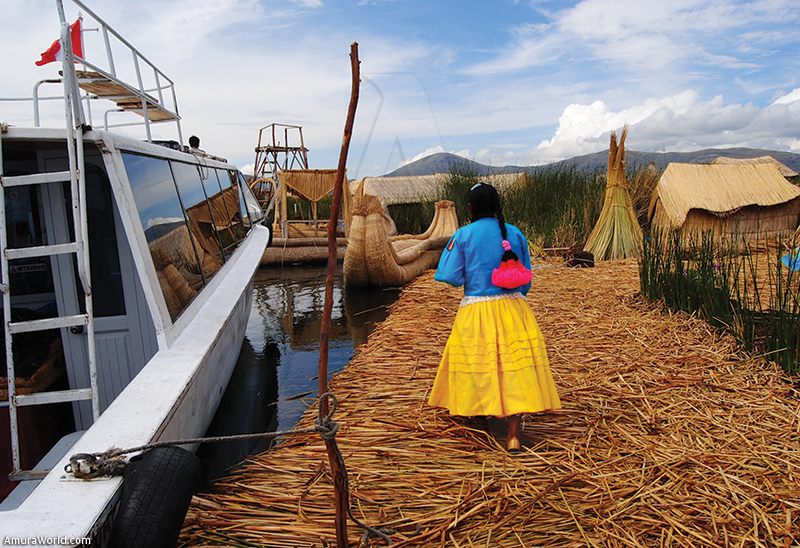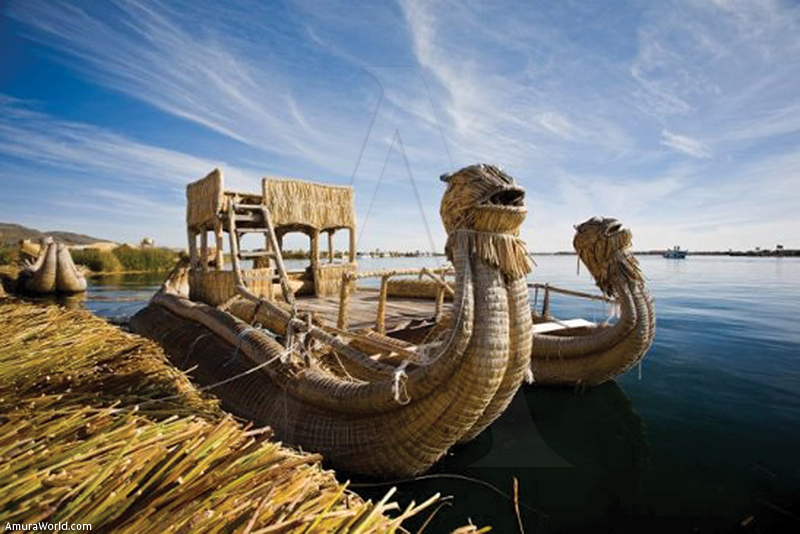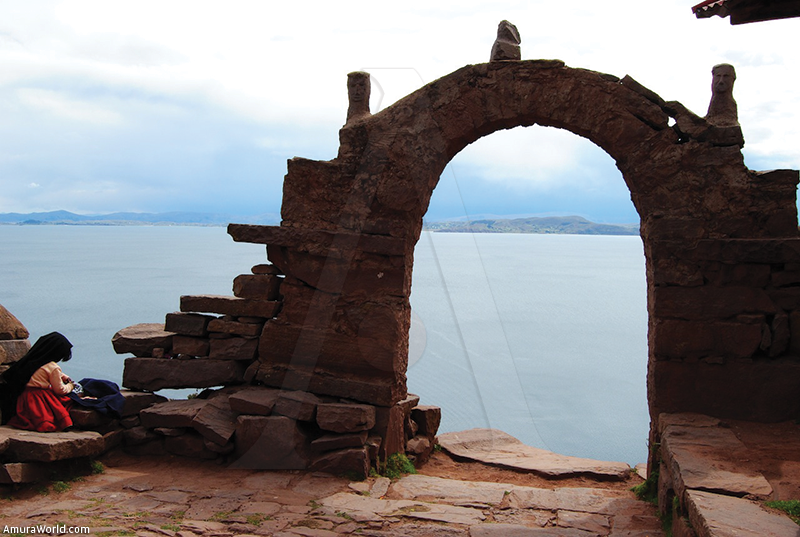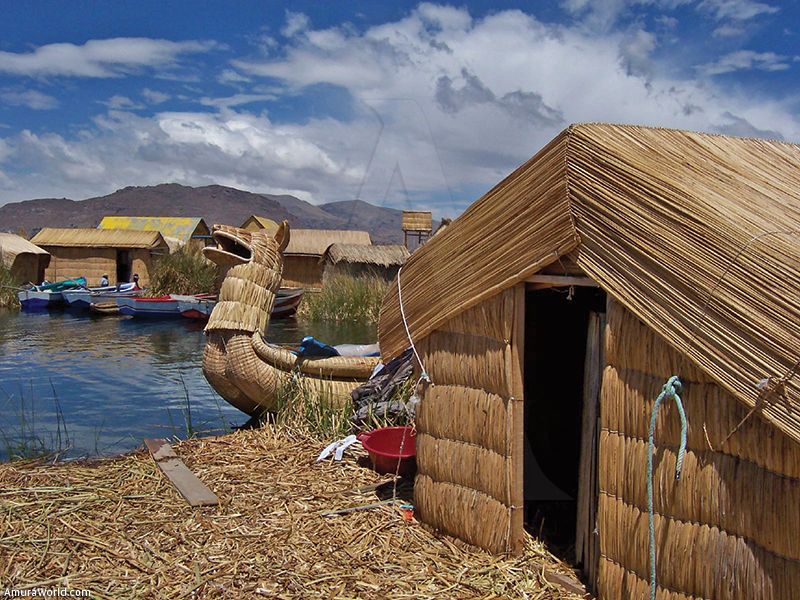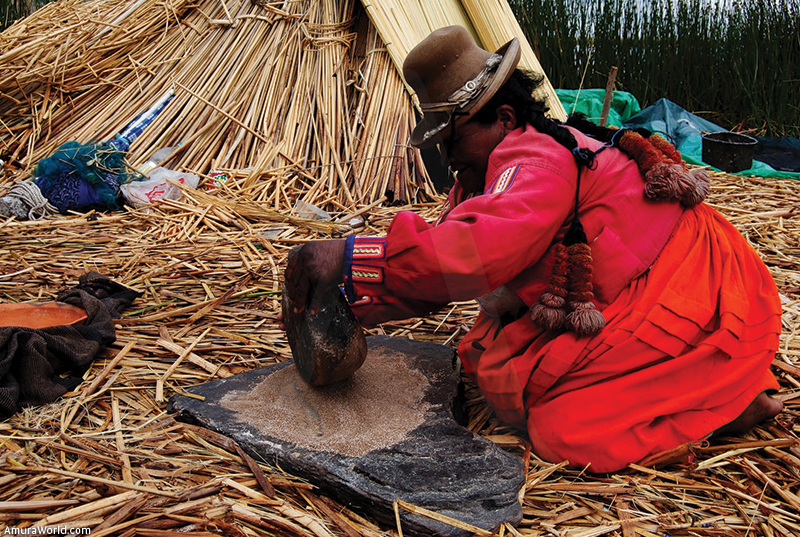Thriving communities living on the water
Lake Titicaca is a natural border between Peru and Bolivia. The city of Puno, in the southeastern part of Peru, serves as a gateway to discover this beautiful natural setting. A native tells us that approximately 60% of this area belongs to Peruvian territory, and 40% to Bolivia.
This lake is situated in what could be the crater of an ancient volcano. Impenetrable leaden waters welcome travelers with some inclement weather. Cold wind and frequent rains are common in the area. Its average altitude is around 3,800 meters above sea level. Visitors should bring something warm in any season; Lets not forget that we are on the Collao plateau, in the foothills of the Andes.
Our trip starts as the boat slowly goes across the sleepy waves. Surprisingly, we find a pig eating in the middle of the lake, on the reed, that great resistant juncal that grows and spreads near the coast. The firmness of the ground is very apparent. Just an hour traveling by boat, and the village of the Uros is in sight.
The community has grown slightly, increasing the number of these small districts or neighborhoods wich spread on the floating islands. “Our daughters are courted by more than one young man in the city, they have money,” says a Peruvian traveler. Thanks to tourism, this community has become one of the most prosperous in Puno.
Each island forms a natural pond built with rectangular piles of mud and bound by ropes. It is a solid surface coated with successive layers of reeds, resulting in a perfect fluffy floating carpet. This is where small houses settle, also manufactured with the reeds. The aquatic plant, a kind of plank tougher, longer and thicker is also part of the diet. The slight tide of this small sea that is the Titicaca subtly moves the entire compound.
These Indians, descendants of Urus, are hunters and fishermen. They have their own schools in the lake; therefore, their social life is marked by the family ties of each community. Because of their development by the water, we could say they are amphibians, with gloomy skin, a clean look and always barefooted, with their feet swollen by moisture, they walk to the city when a specific errand requires. They have added some modern tools to their life: solar panels and motorboats. The tortora boats are only used for short recreational tours with visitors, or any other activity which provides them with a profit. Small huts are reduced to a single space of only four square meters, where all domestic activity takes place. The kitchen, at times, is placed on the outside of the house. With the sale of fabrics, carpets, ceramics and other handmade trinkets that they manufacture, they have prospered as modest merchants. The kinder travelers try on their traditional costumes, thus providing some tips.
Among the many islands located on Lake Titicaca, this is the only one artificially built. The Uros say good bye to visitors with some friendly songs and gratitude. They retain their traditions. They have not made a theme park out of their community, but it is obvious that they profit from tourists’ curiosity.
An island, a mountain
We resume our journey towards Taquile-Intika. The name is in their original language, and owes its Castilian name to the Spanish conquistador, Pedro González de Taquila. After sailing three hours at moderate speed, we approach this small island which looks from a distance as a vision of the Eden. On the hill, a group of children dabble in what seems to be the school playground. Taquile has only about 2,000 inhabitants. The small town main sights are on the top of the mountain, at about 4,000 meters. It is here where weaver men live. The knowledge and crafts manship of the art of weaving marks the passage from adolescence to adulthood. “Nobody can get married if they cannot weave,” says a villager, whose original language is Quechua.
Like other towns in the Andean highlands, people here chew coca leafs. This plant is a symbol and a main element in the life of these communities. It is used as medicine to cure various diseases and for coping with altitude sickness. Men carry inside their caps an appropriate portion, needed to perform agricultural work in the high and steep slopes of the island. They maintain their traditional dress, pants, sash and sleeveless jacket. Agriculture is the hub of community life. Trade is limited mostly to the sale of textiles to tourists. The tranquility that reigns in this place is broken only by the visit of some tourists.
Lake Titicaca is the second largest in South America, after Lake Maracaibo in Venezuela. The Titicaca became world famous after the expedition that the great French oceanographer Jacques Cousteau carried out in the late eighties. Today, many travel agencies offer travelers various itineraries at varying prices. “Http://Taquile.net” is an agency run by the natives, who aims to develop sustainable tourism practices in harmony with the environment.
Here, you will not find hotels or refined services in big restaurants. A healthy alternative is to stay with a local family and enjoy home cooking. Tours usually include a guide, all travel, the boat and meals. Despite being a popular tourist destination for its undeniable value, the exoticism of these places has managed to be kept almost intact. Due to its unique location, the air you breathe is that of privileged places away from the crowds, with colors, air and natural beauty reserved for a few.
Text: Leslie J. López ± Photo: Leslie J. López



